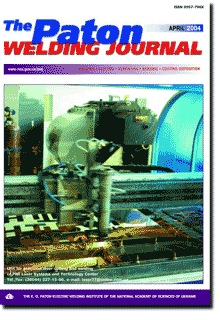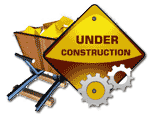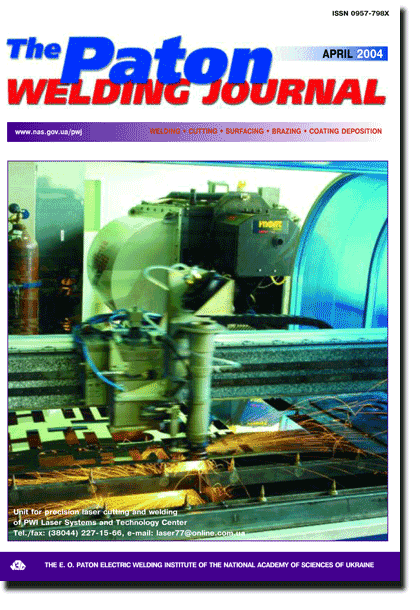

| SCIENTIFIC AND TECHNICAL | |
| Grigorenko G.M., Kostin V.A., Golovko V.V. and Grabin V.F.
Effect of chemical inhomogeneity on the formation of acicular ferrite in high-strength weld metal. | 2 |
| It is shown that the role of non-metallic inclusions in the formation of acicular ferrite is associated with the formation around non-metallic inclusions of regions of a solid solution with an increased content of nickel and manganese and different dislocation structure. Chemical composition of weld metal and different degree of a chemical inhomogeneity in the distribution of austenite-forming elements depend on the change in oxygen potential of the flux and adding of elements of deoxidizers (Al, Ti and Al + Ti) into it. | |
| Peev A.P., Kuzmin S.V. and Lysak V.I.
Distribution of temperature in HAZ in explosion welding of dissimilar metals. | 8 |
| Design-experimental procedure of evaluation of thermal situation in HAZ of explosion-welded dissimilar metals, differing greatly in their physical-chemical properties, are presented. It is shown that the occurrence of molten metal regions at the interface of composite layers is due to the heat generated as a result of a plastic deformation in the stronger metal. | |
| Belous V.Yu., Prilutsky V.P. and Zamkov V.N.
Effect of controlling magnetic field on tungsten electrode in narrow-gap welding of titanium. | 11 |
| It has been established that in the case of using a welding torch, in which the shielding nozzle and collet are located over the gap, and only the tungsten electrode is introduced into the gap, the controlling magnetic field exerts a substantial force effect on the electrode. This circumstance should be taken into account, along with the value of the current load, to ensure reliable operation of the electrode. | |
| Ryzhov R.N., Semenyuk V.S. and Titov A.A.
Peculiarities of formation and crystallization of welds in TIG welding with magnetic arc deflection. | 14 |
| Results of experimental study of the efficiency of application of longitudinal and transverse oscillations of arc, as well as non-reversing and reversing oscillation-rotation movements of arc for control of the processes of formation and crystallization of welds in non-consumable electrode welding are presented. The nature of experimental curves obtained allowed determination of the region of optimum values of parameters of arc deflection and formulation of recommendations for practical application. | |
| Zajtseva N.V., Zakharov S.M., Maksimov S.Yu. and Lyakhovaya I.V.
Properties of austenitic weld metal produced under the water. | 18 |
| Welded joints on low-alloy steels of increased strength made underwater using electrodes with Cr<196>Ni alloy rods have been studied. The effect of the environment on gas saturation level and density of deposited metal, structure and properties of different zones in a welded joint has been evaluated. It is shown that the use of high-alloy electrodes makes it possible to increase ductility and strength of weld metal up to a level of those of the base metal. | |
| Dyadin V.P.
Comparison of impact toughness values of Charpy and Mesnager specimens at tough fracture. | 21 |
| Approach to analytical comparison of the tough fracture energy of Mesnager and Charpy specimens and their components is considered. Simple relationship is suggested allowing the values of impact toughness of the Charpy specimens to be determined from the results of testing the upper shelf of Mesnager specimens. | |
| Kaleko D.M.
Local surface heat treatment by a circular-shaped arc discharge. | 27 |
| Design and experimental procedures were used to demonstrate the possibility of producing by a magnetically-impelled arc a heat-treated section of a circular shape with minimum distortion and higher oil absorption. Characteristics of the HAZ under a magnetically-impelled arc have been studied, and it is shown that the region of a two-times increase of hardness goes down to the depth of 1.5 mm. | |
| INDUSTRIAL | |
| Skulsky V.Yu. and Tsaryuk A.K.
New heat-resistant steels for manufacture of weldments in heat power units (Review). | 32 |
| New grades of heat-resistant structural steels with an increased content of chromium (9-12 %), intended for manufacture of parts operating at supercritical (T > 560-600 oC) and ultra-supercritical (T ~ 620-630 oC) steam parameters, are considered. The effect of alloying on phase composition, corrosion resistance, ageing processes, long-time strength and weldability of steels is analysed. | |
| Zhadkevich M.L., Bondarev A.A., Korsun O.N., Nazarenko S.V., Polishchuk M.A., Minets A.F., Novikov V.I., Didenko S.I., Olekseenko V.A. and Beskorsky M.V.
Electron beam welding of turbine blade packs of 08Kh16N13M2B and 18Kh11MNFBSh steels. | 38 |
| Data is given on weldability in electron beam welding of high-chromium and austenitic steels applied in manufacture of turbine blades. Technology and technique of welding turbine blade packs are described. Modes of blade heat treatment after welding and joint properties are given. | |
| Samokhin M.S., Myalnitsa G.F., Kreshchenko V.A., Samokhin S.M. and Dobkina Yu.G.
Technological peculiarities of argon-arc welding and brazing for repair of cast blades of multicomponent high-chromium nickel alloys. | 41 |
| Structure of cast blades in the as-welded and heat-treated condition has been studied. Austenising of joints prior to welding provides their heat resistance (900 oC) at a level of base metal. Experimental examination of structure of regions in gas turbine engine blades repaired by welding and brazing has been conducted. | |
| Shably O.N., Pulka Ch.V., Pismenny A.S. and Sharik M.V.
Improvement of designs of inductors for induction surfacing of thin elements of machine parts. | 47 |
| Existing designs of inductors for induction surfacing of thin elements of flat parts, including shaped discs, are considered and analyzed. New designs of inductors and heating systems developed by the authors to reduce the energy content to improve the surfacing process efficiency and deposited metal quality, are described for induction surfacing of thin steel toothed discs. | |
| BRIEF INFORMATION | |
| Zhudra A.P., Krivchikov S.Yu. and Petrov V.V.
Selection of boron-containing charge materials for the core of flux-cored wire. | 51 |
| Results of experimental studies of the effect of different powdered boron-containing materials (amorphous boron, boron nitride, boron trioxide, boron carbide and iron-chromium-boron master alloy) contained in self-shielded flux-cored wire on structure, hardness and crack resistance of high-carbon deposited metal are given. It is shown that deposited metal alloyed with boron, using the iron-chromium-boron master alloy, has the most favourable physical-mechanical properties. | |
| Thesis for a scientific degree. | 53 |
(You are viewing the simplified file contents)
The cost of subscription/purchase order journals or individual articles
| Journal/Currency | Annual Set | 1 issue printed |
1 issue |
one article |
| TPWJ/USD | 384 $ | 32 $ | 26 $ | 13 $ |
| TPWJ/EUR | 348 € | 29 € | 24 € | 12 € |
| TPWJ/UAH | 7200 UAH | 600 UAH | 600 UAH | 280 UAH |
| AS/UAH | 1800 UAH | 300 UAH | 300 UAH | 150 UAH |
| AS/USD | 192 $ | 32 $ | 26 $ | 13 $ |
| AS/EUR | 180 € | 30 € | 25 € | 12 € |
| SEM/UAH | 1200 UAH | 300 UAH | 300 UAH | 150 UAH |
| SEM/USD | 128 $ | 32 $ | 26 $ | 13 $ |
| SEM/EUR | 120 € | 30 € | 25 € | 12 € |
| TDNK/UAH | 1200 UAH | 300 UAH | 300 UAH | 150 UAH |
| TDNK/USD | 128 $ | 32 $ | 26 $ | 13 $ |
| TDNK/EUR | 120 € | 30 € | 25 € | 15 € |
AS = «Automatic Welding» - 6 issues per year;
TPWJ = «PATON WELDING JOURNAL» - 12 issues per year;
SEM = «Electrometallurgy Today» - 4 issues per year;
TDNK = «Technical Diagnostics and Non-Destructive Testing» - 4 issues per year.


